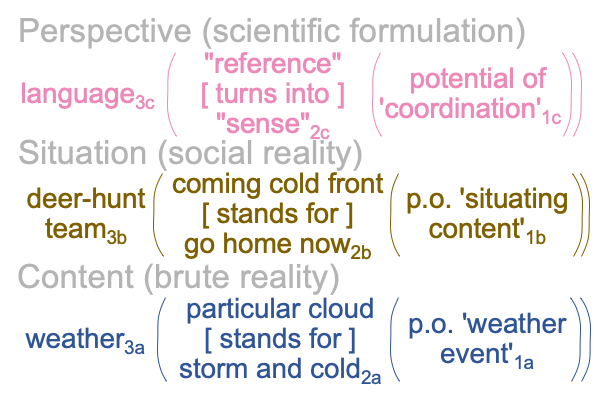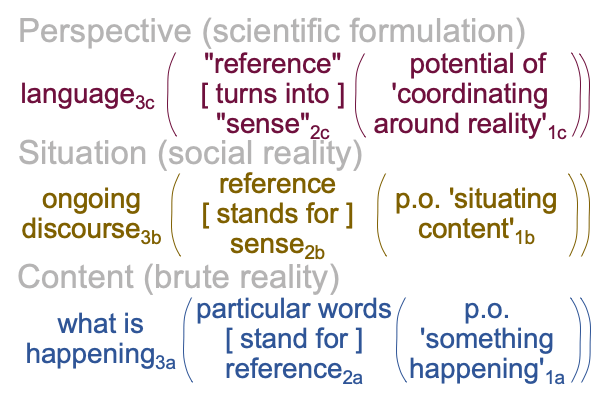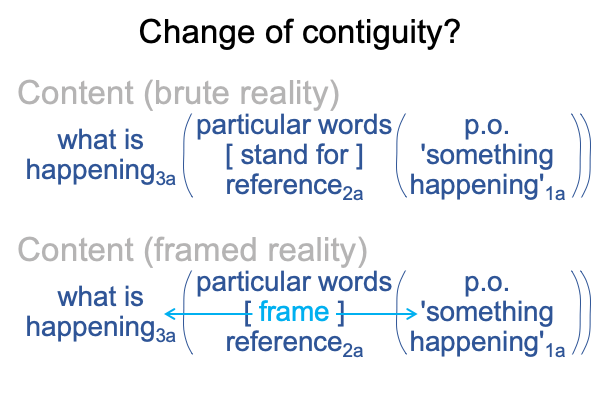0898 Chapter three is titled, “Language and Nature”.
Already, I presented a scene occurring around the time of the domestication of fire, say 750,000 years ago, when a particular cloud2a (SV) stands for a coming storm bringing bitter cold2a (SO) in regards to weather3a and the potential of a weather event1a (SI).
0899 This sign-relation is not quite the same as the specifying sign-relation discussed in Looking at John Deely’s Book (2010) “Semiotic Animal”, appearing in Razie Mah’s blog in October 2023.
But, it is close.
0900 The same pattern, where a sign-relation is flattened into a single level of an interscope, applies to the situation level. An anticipated cold front2b (SV) stands for the need to go home now2b (SO) in regards to the deer-hunting team3brealizing its predicament1b (SI).
These two signs involve hand talk. For the first, if nothing else, one team member points out the particular cloud. For the second, hand talk can express the actuality quite well with the following statement.
[Image STORM][Image TEETH][Image COLD][Image BITE]
Translation?
Storm teeth bite cold.
0901 Now, a linguist and cognitive psychologist, who observes this scene through a time-suspending portal devised to surveille the distant past without being detected, would be very interested in how hand-talk translates the physical reality of the storm, the “reference”, to the social reality of a retreat, the “sense”.
The German philosopher, Gottlob Frege (1848-1925 AD), offers the labels of “reference” and “sense”.
To me, “reference” associates to physical reality and “sense” associates to social reality.
0902 How do these labels play out when regarding the interscope for the ongoing example?

Well, the perspective level looks a little awkward, because it really reduces the content-level actuality2a to something that associates to “reference”2a and the situation-level actuality2b to something that associates to “sense”2b. So, I put the nested form in a lighter color.
After all, the terms, “reference” and “sense”, are explicit abstractions with different implications than “physical reality” and “social reality”.
0903 Frege moves the paradigm towards our current Lebenswelt, which is characterized by speech-alone talk. Speech-alone talk facilitates explicit abstraction. Hand and hand-speech, along with the evolved trait of implicit abstraction, fade into the background. Speech-alone talk moves to the foreground.
Indeed, Frege’s terminology allows a generalization of the example, into the following interscope.

0904 This general interscope allows the reader to see how framing is a feature, not an option.
But, what does “frame” mean?
0905 Here is an example.
In terms of physical reality, when a person needs to get somewhere, he “walks”. If the person has to go faster, he “runs”.
So, the choice of “walks2a” as opposed to “runs2a” frames the reference2a.

Of course, framing the reference2a also will alter the sense2b.
0906 Now, if I am at a tea party, and if I want to appear more sophisticated than I actually am, then I might employ the terms, “shuffle”, “saunter”, “stroll”, “jog”, “dash” and “sprint”.
This terminological efflorescence attracts academic interest. Short videos of someone moving on a college campus at different speeds and modes are shown to students in order to assess the above spectrum of terms. Researchers change the reference and see how the word-sense changes.
Theoretically, I suppose that this scientific inquiry establishes a correlation between particular words2a and the sense of those words2b, because the reference2a,2b consists of recorded videos. It is like a controlled laboratory experiment.
